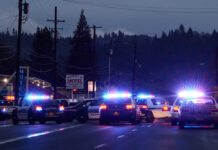
A helicopter charter company with a history of dangerous incidents has suffered its deadliest crash yet, leaving six people dead as the aircraft shattered midair over the Hudson River.
At a Glance
- A New York Helicopter Charter Bell 206 helicopter crashed into the Hudson River, killing the pilot and a Spanish family of five
- The same company experienced previous incidents in 2013 and 2015 involving emergency landings, though without fatalities
- Alarming footage captured the helicopter breaking apart midair before crashing
- CEO Michael Roth claimed to have “no clue” about the cause, despite his company’s troubling safety record
- Recovery efforts and investigations into potential rotor blade failure are ongoing
A Pattern of Dangerous Incidents
Some companies just shouldn’t be in business. New York Helicopter Charter appears to be developing quite the habit of dropping aircraft into the Hudson River. Their most recent and deadliest incident killed a pilot and five Spanish tourists, including Agustin Escobar, CEO of Siemens in Spain. The wreckage is still being recovered as investigators piece together what caused yet another helicopter from this company to fail catastrophically. But this wasn’t their first rodeo on the Hudson – their Bell 206 helicopters seem particularly attracted to the water.
Back in June 2013, one of their helicopters lost power and had to make an emergency landing in the same river. Miraculously, the Swedish tourists aboard survived that incident without injuries. The National Transportation Safety Board (NTSB) eventually attributed that crash to a “maintenance error” and “engine lubrication abnormality.” In other words, someone didn’t do their job properly. Yet somehow, this company kept right on flying tourists over one of America’s most densely populated cities.
More Red Flags Ignored
As if one water landing wasn’t enough, the company had another Bell 206 make a “hard landing” in New Jersey in 2015 due to control issues. That same helicopter had previously been involved in another hard landing in Chile in 2010. At what point does coincidence become negligence? You have to wonder just how many incidents it takes before regulatory agencies step in to protect the public from companies with questionable safety records.
The latest tragedy shows the devastating consequences when safety issues aren’t properly addressed. The helicopter didn’t just crash – it broke apart midair, as captured in disturbing footage. This suggests catastrophic mechanical failure, possibly involving the rotor blades, rather than pilot error. When helicopters start disintegrating over major metropolitan areas, something has gone terribly wrong with our oversight system.
CEO Claims Ignorance Despite History
Perhaps the most infuriating aspect of this tragedy is CEO Michael Roth’s response. He expressed devastation and claimed to have “no clue” about what caused the crash. Really? No clue at all, despite your company’s helicopters having an alarming tendency to fall out of the sky? This is the same CEO who was in charge during the previous incidents, including the 2013 Hudson River landing. At some point, ignorance stops being an excuse and starts looking like willful negligence.
The families of the victims deserve better than “I have no clue” from the man responsible for maintaining these aircraft. Six people lost their lives here – a Spanish family enjoying what should have been a memorable vacation experience and a pilot who trusted his employer to provide safe equipment. How many more people need to die before we see meaningful accountability for companies that put profits over passenger safety?
Where Are The Regulators?
This tragedy raises serious questions about the oversight of helicopter tour operations. How did a company with multiple previous incidents continue operating without stricter supervision? The Federal Aviation Administration seems perpetually reactive rather than proactive when it comes to safety enforcement. We establish regulatory agencies precisely to prevent companies with questionable safety records from continuing to endanger the public, yet somehow these helicopters kept flying.
As recovery efforts continue and investigators examine the wreckage, we can only hope this case finally brings meaningful change to helicopter tour safety regulations. The pattern of incidents from this single company suggests systematic problems that likely extend beyond just one operator. In a sane world, a company with this many “incidents” wouldn’t be permitted to continue putting tourists’ lives at risk. But accountability seems in short supply these days, especially when it comes to businesses with powerful friends.

























